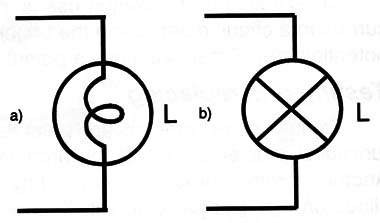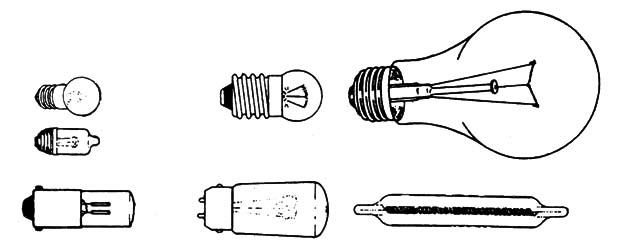Incandescent lamps are formed by a tungsten filament placed inside a glass enclosure where the oxygen is removed. When the electric current heats the filament to a very high temperature, it produces light. The metal of the filament doesn’t burn because there is no oxygen to be a source of a combustion chemical reaction.
Electronic equipment usually uses small incandescent lamps rated for low voltage in the range between 1.5 and 12 V. This is an important difference from the lamps found in electric applications that are primarily used to illumination purposes and are powered directly from the AC power-line voltage.
Symbols and Types
Figure 1 shows the symbols used to represent small incandescent lamps.

In (a), the American symbol is shown and in (b), the symbol found in some diagrams from European manufacturers is shown. Figure 2 illustrates the common types used as panel or Instrument Indicators and for other functions.

Observe that the base of the lamp changes in format or size according to the application. The main types are the bayonet base, telephone slide, flange, and threaded.
Specifications
A. Nominal voltage
This is the operational voltage of the lamp. Common types are indicated to operate in the range between 1.5 and 12 V.
B. Nominal current
This is the current flowing through the filament when the nominal voltage is applied. Common types can be specified to operate with currents in the range between 0.01 A (10 mA) and 1 A.
C. Type number
Many catalogs indicate the type of a lamp by a part number giving tables where the electric and mechanical specifications are placed. Types such as “47” are popular. This is a lamp rated to 6.3 V x 150 mA using a bayonet base.
Where they are found
The incandescent lamps can be found basically in all applications where illumination of a panel, instrument, or control is needed. In many pieces of equipment, small incandescent lamps are placed inside the panel instruments.
Although LEDs are replacing the lamps in many applications, those with white light production capabilities are becoming popular. These lamps are used as replacements in antique equipment and some modern applications.
Testing and Replacement
The small incandescent lamps have low filament resistances (varying according to their voltage and current). If the filament burns up, the resistance becomes infinite.
Using a multimeter, it is easy to see if an incandescent lamp is good or not good. When replacing a lamp, if the part number is not available, the electrician must know the voltage and current and take care to choose one with the same base format.



